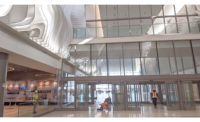 |
| Rooftop Dish. Landside and airside had two architectural teams but one continuous look. Signature feature collects rain for waterfall inside. |
Sharon said the new terminal, "with cutting edge technology and futuristic architecture, was one of the largest infrastructure projects" in the country. He said David Ben Gurion, the airports namesake and Israels first prime minister, had recognized the importance of development, saying "even in the most difficult times we have to remember things beyond the horizon."
|
Israel has much on the horizon. Kobi Haber, finance ministry budget director, has just announced a $5-billion infrastructure spending plan for 2005, up 13% from spending in 2004. The program includes water, desalination, transport and energy projects. In addition, Haber expects $3 billion of private sector investment in infrastructure. Among the projects with private financing are the desalination plants along the Mediterranean coast, private powerplants, an extension of the cross-Israel highway and a $1-billion highway linking Modiin and Rishon Le Zion. At the local level, the Jerusalem Municipality is negotiating a final contract with its BOT concessionaire for the first line of its light-rail system.
One of the biggest projects under way in the country is the National Rail Project. Israel Railways is investing $4.5 billion over the next five years in work such as a new high-speed train from Tel Aviv to Jerusalem and one to Eilat. On Oct. 27, the finance ministry awarded New York City-based Parsons Brinckerhoff a three-year, $5.3-million contract. "Well be the eyes and ears of the ministry on effective and efficient use of resources on 33 projects," says Michael Schneider, PB executive vice president.
Still other projects include the national gas transmission network. The state-owned gas company is putting out tenders for a $500-million land-based pipeline section in the coming months.
Good Fences
Despite continued isolated attacks, Israeli officials believe the array of fences, walls and trenches designed to impede terrorists threats, which will eventually stretch 750 kilometers along Israels border, is doing its job. Ido Aharoni, New York City-based public affairs consul, says the barrier has brought a 95% reduction in the ability of terrorists to carry out their plans. Current attackers are coming through where the fence has not yet been finished, he says. Israel plans to add 168 check points and gates to help law-abiding travelers commute into the country to work or visit family, he adds.
 |
| Waterfall. Curtain of recirculated rainwater tranquilizes the airports airside central plaza. |
The new terminal was planned with a decrease in hostilities and an increase in tourism in mind. The $800-million terminal will accommodate 16 million passengers when all five concourses are built. It opened with three concourses and a 9-million-passenger capacity.
The Israel Airports Authority hired two teams of architectsan international architect with airport experience and a local partnerfor the airside and landside of the project. "We selected the glass together, the flooring together and used the same granite," said Irit Kohavi, principal in the Jerusalem office of Moshe Safdie Architects Ltd., airside designer. The distinctive feature is a rooftop dish that collects rainwater, which is filtered and recirculated in a waterfall inside. It "tranquilizes the atmosphere" of the shopping plaza and also "cools and cleans the roof," said Safdie.
Landside design by Skidmore, Owings & Merrill with local Karmi Architects features "light scoops" that channel desert light around columns deep into interior halls. Ove Arup and Partners with local firms provided structural and mechanical engineering.
 |
| Team Safdie,Taylor designed side by side. |
A major challenge was adding a 180 x 45-meter checked baggage screening facility after the structure was in place for the landside terminal when the authority decided to screen all checked bags. "You have to love change to love airports," says Marilyn Jordan Taylor, SOM partner in charge of the firms airports practice.
Mark Bodner, vice president in the New York City office of Bovis Lend Lease, the projects agency CM, says the buildings piles were designed with both end-bearing and friction-bearing capacity. To counter the loss of friction as the existing 1.5-m-dia piles effectively became columns in the new underground space, additional piles were added on either side of the main supports. The basement was excavated progressively and a ring collar was cast to tie the new piles to the older ones. All piles were interconnected by a grid of beams.
The airport also decided to accelerate construction of a future train station after the landside terminal building and adjacent roadway were structurally complete.
wo days after winning a crucial vote on beginning to remove Israeli settlements from Gaza, Prime Minister Ariel Sharon appeared at the Oct. 28 opening ceremonies of the new 2.4-million-sq-ft terminal at Ben Gurion International Airport. "We do not need a referendum to determine that this terminal is wonderful," he chided, referring to his opponents demand for a referendum on the Gaza plan.

.jpg?height=200&t=1675343845&width=200)

Post a comment to this article
Report Abusive Comment